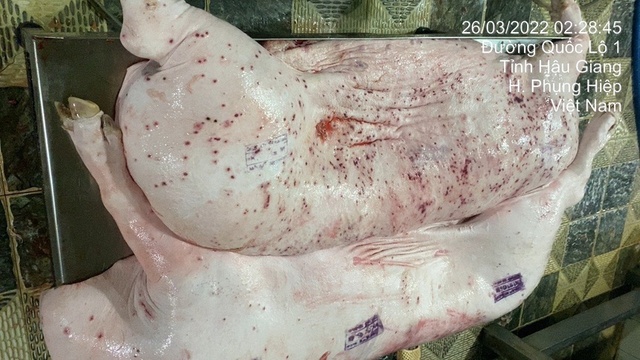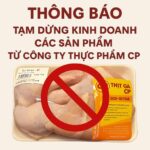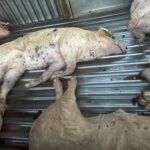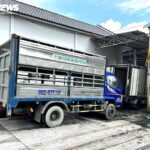During the Ministry of Agriculture and Environment’s regular press briefing on the morning of June 3rd, Deputy Director of the Department of Livestock and Veterinary, Nguyen Thu Thuy, addressed concerns regarding allegations of dead pigs being supplied to C.P.’s food outlets, which were posted on a social media account. Thuy stated that the Department had immediately requested a report and clarification from C.P. upon learning of the incident.
Initial investigations revealed that the images shared by the social media account were from an incident in 2022 at a Dững Nga slaughterhouse in Hau Giang Province.
Notably, regarding slaughter control, Thuy pointed out that the stamp on the pig in the online images was incorrect. She explained that the square stamp on the meat was inappropriate, as square stamps are only used for market circulation.
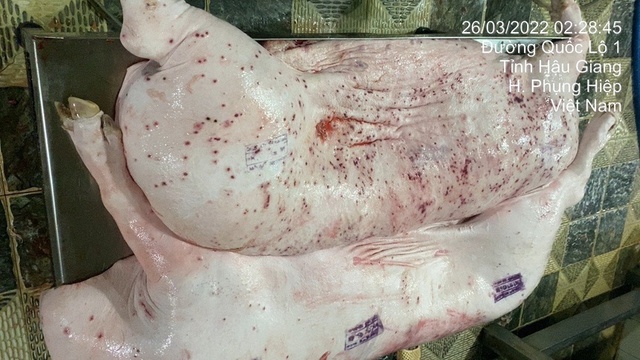
Image posted by social media account “J.L.” accusing C.P. Vietnam of using square stamps
According to Consolidated Text No. 09/2016/TT-BNNPTNT, issued by the Ministry of Agriculture and Rural Development, only livestock products that have undergone veterinary hygiene inspection and met the requirements after slaughter are eligible for stamping. The stamp serves as confirmation that the product is safe for domestic consumption or export, while also preventing the mixing of unidentified meat sources in the market.
The stamps used for slaughter control on livestock carcasses for domestic consumption, including their shape, size, and content, are clearly defined. These stamps are used to certify that the meat has been inspected and meets veterinary hygiene requirements.
1. Stamp for slaughter control on livestock carcasses for domestic consumption
This stamp is used for carcasses that are not intended for export but meet veterinary hygiene requirements for domestic consumption. It is applied after the veterinary authority confirms that the meat shows no signs of disease and meets hygiene standards.
Dimensions: 80 x 50 mm.
Divided into three horizontal parts: top/bottom width of 13 mm, middle width of 20 mm. Content: Top: “DEPARTMENT OF VETERINARY” (8 mm high letters); Middle: “DOMESTIC” (12 mm high letters); Bottom: Slaughterhouse code (8 mm high letters).
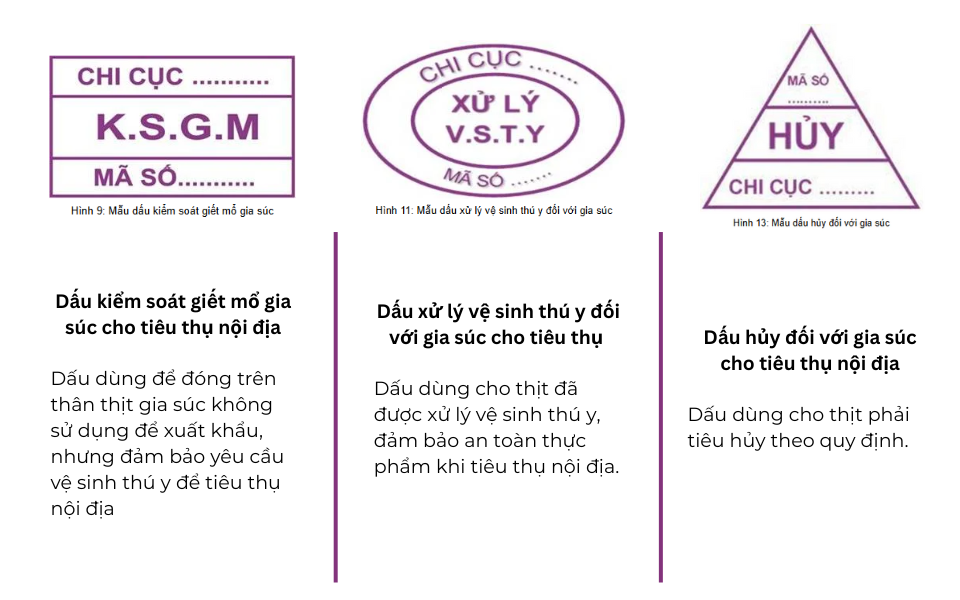
2. Stamp for carcasses that have undergone veterinary hygiene processing
The stamp is in the shape of an oval with outer dimensions of 80×50 mm and inner dimensions of 60×30 mm. The border is 1 mm thick.
Content: On the outer circle: “DEPARTMENT OF VETERINARY” (4 mm high letters); Inside the circle: “PROCESSED V.S.T.Y” (8 mm high letters). Below the outer circle: Facility code (4 mm high letters).
This stamp is used for carcasses that have undergone veterinary hygiene processing and are safe for consumption.
3. Stamp for carcasses that must be destroyed
The stamp is in the shape of a triangle with a side length of 80 mm and a border of 1 mm. It is divided into three parts vertically: 30 mm (top), 22 mm (middle), and 15 mm (bottom).
Content: Top: Facility code (8 mm high letters); Middle: “DESTROY” (12 mm high letters); Bottom: “DEPARTMENT OF VETERINARY” (8 mm high letters).
This stamp is used for carcasses that must be destroyed according to regulations.
The stamps for quarantine and slaughter control are directly managed by the local Veterinary Sub-Departments. Each stamp has a unique code that includes the slaughterhouse code, the veterinary inspector’s code, and the inspection date. Specialized ink is used for stamping to ensure it does not affect the quality of the meat or pose any harm to consumers.
Strict adherence to regulations regarding quarantine and slaughter control stamps is crucial for ensuring food safety, preventing the spread of diseases, and protecting consumers’ health. Authorities and businesses should strengthen inspections and supervision to promptly address any violations and maintain the reputation of the livestock industry and the food market.
Phàm Trang
The Ultimate Guide to C.P.’s Meat Shops in Can Tho: A Comprehensive Inspection
On the morning of June 3rd, an inspection team from the Department of Animal Husbandry and Veterinary Medicine, in collaboration with the Market Management Bureau of Can Tho city, conducted inspections at several food establishments operated by C.P. Vietnam Livestock Joint Stock Company (C.P. Company) in Ninh Kieu district.
“Local Grocer Takes a Stand: No More C.P. Products on Our Shelves”
This food store has announced that it will be halting the supply of C.P. products until further notice, pending an official statement from the relevant authorities.

